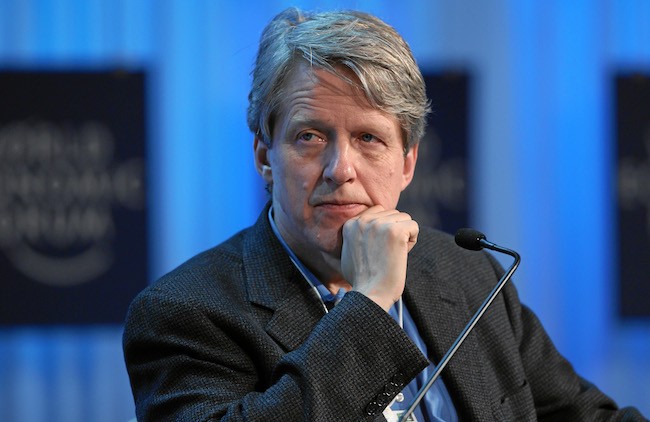Handicapping the 2013 Economics Nobel Real Time Economics
Post on: 16 Март, 2015 No Comment

Nobel Prize
Forecasting Nobel laureates is a thankless exercise but that hasn’t stopped the predictions. This is Nobel week: Monday was medicine, Tuesday physics and Wednesday chemistry. Literature and peace follow today and Friday, respectively. And on Monday, Oct. 14, the spotlight turns to economics.
Here are names some perennials on Nobel shortlists that economists say are contenders for what many consider the field’s highest honor.
Getty Images 2012 economic Nobel laureates Alvin Roth and Lloyd Shapley
If the award is for work on financial crises, banks, liquidity and regulation, Douglas Diamond of the University of Chicago Booth School of Business and Philip Dybvig. of the Olin School of Business at Washington University, St. Louis. are headliners. In 1983, the pair wrote a seminal paper spelling out why bank runs happen. The authors explained that deposit insurance could reassure customers and keep them from panicking and pulling their money out en masse.
Another name cited for finance and regulation is Jean Tirole. of the Toulouse School of Economics. who has done work on industrial organizations, antitrust and the regulation of corporations. Other potential winners in this area include Bengt Holstrom. of the Massachusetts Institute of Technology ; Oliver Hart. of Harvard University ; Gary Gorton. of the Yale School of Management and Paul R. Milgrom of Stanford University. Mr. Milgrom’s areas of research include auctions, akin to last year’s laureates. Alvin Roth and Lloyd Shapley. Messrs. Roth and Shapley worked, separately, on how markets, such as the system for pairing medical residents with hospitals, come up with matches.
For his fundamental work in finance, game theory and corporate economics, David Kreps. of Stanford Business School. also is seen as a potential laureate.
Some observers say 2013 may be the year for econometrics the application of math and statistics to economic data because the most recent Nobel in the area was awarded 10 years ago. to Robert Engle and Clive Granger .
If they are correct, Lars Peter Hansen. of the University of Chicago. is seen by many as a shoo-in. He developed a widely used econometric tool, the Generalized Method of Moments, for running regression analyses, which economists use to uncover relationships among variables. Jerry Hausman. of the Massachusetts Institute of Technology. also is considered a strong candidate.
If 2013 is the year for behavioral economics, contenders include Robert Shiller. of Yale. who challenged the idea that financial markets are completely efficient, with asset prices reflecting all available information at a given moment. Instead, movements in stock prices are far more volatile than would be justified by fundamental information, such as dividends. Prices, Mr. Shiller concluded, move for many strange reasons.
One reason for market inefficiency, according to another possible Nobelist, Richard Thaler. of the University of Chicago Booth School of Business, may be the fact that people have biases and don’t always make the best long-term decisions.
If the Nobel honors work on economic growth, many see Paul Romer. of New York University ’s Stern School of Business, and Robert Barro. of Harvard. as inevitable. A handful of key papers by Mr. Romer emphasized the importance of investment in human capital, ideas, innovation and research and development in expanding an economy. Mr. Romer runs NYU’s Urbanization Project, which helps cities plan to absorb expanding populations and also is working on establishing completely new cities. Mr. Barro, in research from the early 1990s. used personal income and state growth data from the U.S. to show that poor regions or countries expand faster than rich ones.
Other possible Nobelists for economic growth include Philippe Aghion. of Harvard. and Peter Howitt. who have written papers and books together on the subject. They have focused on Schumpeter’s idea of “creative destruction” in which an economy grows because competition spurs inventions as well as innovation in technology.
Princeton ’s Angus Deaton. who has studied growth and economic development in rich and poor countries, also is said to be in the running.
For some time, news and data firm Thomson Reuters has published predictions of Nobel laureates. based on research citations. The firm is one for three in its 2013 forecasts, nailing the physics winners but missing the mark in medicine and chemistry. (The physics prize went, as widely expected, to François Englert and Peter Higgs. the scientists behind the “God particle” breakthrough.)
Thomson Reuters’ predictions start with Joshua Angrist. of the Massachusetts Institute of Technology ; David Card. of the University of California, Berkeley and Alan Krueger. of Princeton. for “their advancement of empirical microeconomics.”
Their research has tapped “natural experiments” to understand health, education and labor markets. Messrs. Angrist and Krueger studied how the Vietnam lottery draft affected mens’ lifetime earnings. Mr. Card examined the effect of the 1980 Mariel boat lift. which brought Cuban emigrants to Miami, on the city’s labor market. He also worked with Mr. Krueger on a paper studying the effects of the minimum wage on employment .
Thomson Reuters’ slate also includes Sir David Henry. of Oxford ; M. Hashem Pesaran. of Cambridge and the University of Southern California at Los Angeles ; and Peter Phillips. of Yale. for “their contributions to economic time-series, including modeling, testing and forecasting.”

The firm’s predictions conclude with a pair of University of Chicago candidates: Sam Peltzman. of the Booth School, and Judge Richard Posner. of the Law School, for “extending economic theories of regulation.”
The winner of the economics prize known as the Sveriges Riksbank Prize in Economic Sciences in Memory of Alfred Nobel is determined by members of the Royal Swedish Academy of Sciences. The prize was begun in 1968, to mark the 300th anniversary of Sweden’s central bank—the world’s oldest central bank. The first such prize was conferred in 1969; today’s prize is about 8 million Swedish kroner ($1.2 million).
A committee at the Royal Swedish Academy solicits nominations from economists and other academics. Former laureates and Academy members also can propose candidates. Lobbying is keen and often persists for years, according to people familiar with the process. The honorees—if there are more than one—haven’t necessarily collaborated with one another on papers and research, but have done complementary work.
A hallmark of the selection process is secrecy, with the Academy adept at keeping its thinking to itself before announcing the decision. The John Bates Clark medal. awarded to an outstanding U.S. economist under age 40, is something of a predictor. A number of Clark medalists, including Gary Becker. Joseph Stiglitz and James Heckman. have gone on to win Nobels. (Clark medalists among the possible 2013 contenders cited here are Jerry Hausman. David Kreps and David Card .)
However, people familiar with the Nobel process pointed out a key distinction: The Clark medal honors an economist while the Nobel is a prize for economic science, more about a breakthrough that transformed the field and informed the world than a flash of individual brilliance.
The Academy’s prize committee enlists experts to spend months vetting the suggestions. On Monday morning, the panel puts its recommendation to the entire Academy for a vote. The winner or winners are notified by telephone and the award is announced shortly thereafter, in Stockholm.
Follow @WSJecon for economic news and analysis
Follow @WSJCentralBanks for central banking news and analysis
Get WSJ economic analysis delivered to your inbox:














